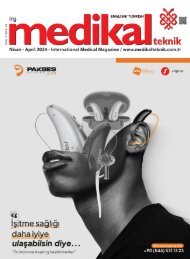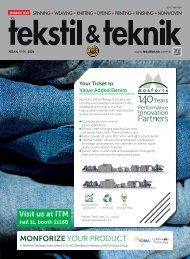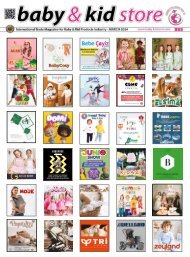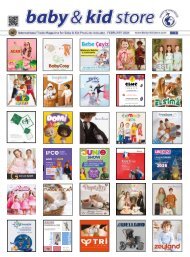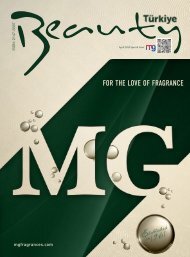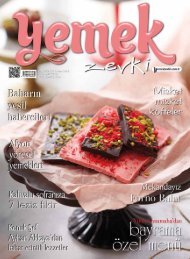Baby & Kid Store November 2020
Baby & Kid Store November 2020
Baby & Kid Store November 2020
- TAGS
- kid-laundry
- children-sweater
- children-coat
- children-pants
- special-dress
- baby-kid-fair
- baby-kids-textile
- unisex-baby-wear
- children-sportswear
- baby-fashion
- kids-fashion
- baby-wear-clothes
- baby-kids-fashion
- baby-cotton-clothes
- girl-kids-clothes
- boy-kids-clothes
- sportswear-children-for-kids
- newborn-baby-clothes
Create successful ePaper yourself
Turn your PDF publications into a flip-book with our unique Google optimized e-Paper software.
Fashion About Us
The Baby Clothes to grow by 6%
Revenue in the Baby Clothes segment amounts to US$43,782 m in 2020, and is expected to
grow annually by 5.5% between 2020 and 2025
Revenue in the Baby Clothes segment amounts to US$43,782
m in 2020. The market is expected to grow annually by 5.5%
(CAGR 2020-2025).
This research covers the current Baby Clothing market size of
the market and its growth rates based on 5-year records with
company outline of Key players/manufacturers
COVID-19 can affect the global economy in three main ways: by
directly affecting production and demand, by generating supply
chain and market disruption, and by its financial impact on
firms and financial markets.
Baby clothing, these colorful clothes are designed for baby boys
and baby girls with various types like suits, jackets, sweaters,
pants, T-shirts, etc. Cotton is the most used material of baby
clothing due to its characters like sweat-absorbent, soft and
comfortable. Wool, fur, linen and silk are also the major fabric
materials.
The current key players/manufacturers in the Baby Clothing
market worldwide are Cotton On, Naartjie, H&M, Converse Kids,
Earthchild, Witchery, Exact Kids, NIKE, Cotton Candyfloss, Foschini,
Mr Price, Zara, Truworths, Edcon, Carters, GAP, and JACADI.
With the continuous development of the economy in South Africa,
the growth rate in recent years has declined to some extent,
but the baby clothing market is relatively stable, it is expected
in the next few years will continue this state. The development
of consumer goods market influenced by the impact of regional
macroeconomic, while the impact of geopolitics, while the
domestic textile technology is not advanced enough, compared
to China and Bangladesh products without cost Advantage, also
no brand advantage. Although the baby clothing market in South
Africa is very large, but its domestic baby clothing business there
is still much room for development. The worldwide market
for Baby Clothing is expected to grow at a CAGR of roughly 5,5%
over the next five years, will reach 49, 571 million US$ in 2024,
from 41, 632 million US$ in 2019, According to a New Research
study of the report focuses on the Baby Clothing in global market,
especially in North America, Europe and Asia-Pacific, South
America, Middle East and Africa.
Report further studies the market development status and future
Baby Clothing Market trend across the world. Also, it splits
Baby Clothing market Segmentation by Type and by Applications
to fully and deeply research and reveal market profile and
prospects.
Major Classifications are as follows: Coverall, Outerwear, Underwear
and Others.
Major Applications are as follows: 0-12 months, 12-24 months
and 2-3 years.
The market of baby clothing is growing significantly
Baby clothing refers to clothing that is designed for the children
belonging to the age group of 0 to 36 months and has a length
of 86 meter. In the earlier years, baby clothing which the babies
wore was generally made up by the parents. However, in the
later years, retailers decided to produce children’s goods which
resulted in significant rise in the sales of the baby clothing.
Changing lifestyle, increase in the women working population
has increased the consciousness among the population regarding
proper presentation of their babies. Therefore, the market
of baby clothing is growing significantly. Product innovation in
order to develop new styles due to continuous demand among
the consumers has become a key success for the baby clothing
manufacturers.
The global baby clothing market has been segmented on the
basis of materials, types and distribution channel. On the basis
of materials, the global baby clothing market has been segmented
into cotton baby clothing, wool baby clothing, and silk baby
clothing. Cotton based baby clothing are popular among the
population due to the comfort. Silk-based baby clothing also
occupied a significant market share due to the rising demand
for the fashionable wear coupled with the inclination towards
the proper presentation of their babies in different occasions.
58
November
2020



